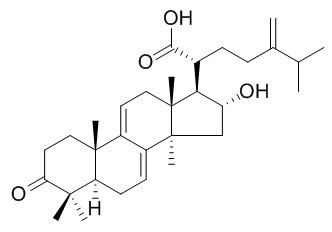Polyporenic acid C
Polyporenic acid C shows inhibitory activity against human collagenase. Polyporenic acid C induces apoptosis through the death receptor-mediated apoptotic pathway where the activation of caspase-8 leads to the direct cleavage of execution caspases without the involvement of the mitochondria.
Inquire / Order:
manager@chemfaces.com
Technical Inquiries:
service@chemfaces.com
Tel:
+86-27-84237783
Fax:
+86-27-84254680
Address:
1 Building, No. 83, CheCheng Rd., Wuhan Economic and Technological Development Zone, Wuhan, Hubei 430056, PRC
Providing storage is as stated on the product vial and the vial is kept tightly sealed, the product can be stored for up to
24 months(2-8C).
Wherever possible, you should prepare and use solutions on the same day. However, if you need to make up stock solutions in advance, we recommend that you store the solution as aliquots in tightly sealed vials at -20C. Generally, these will be useable for up to two weeks. Before use, and prior to opening the vial we recommend that you allow your product to equilibrate to room temperature for at least 1 hour.
Need more advice on solubility, usage and handling? Please email to: service@chemfaces.com
The packaging of the product may have turned upside down during transportation, resulting in the natural compounds adhering to the neck or cap of the vial. take the vial out of its packaging and gently shake to let the compounds fall to the bottom of the vial. for liquid products, centrifuge at 200-500 RPM to gather the liquid at the bottom of the vial. try to avoid loss or contamination during handling.
Nat Prod Sci.2016, 22(2)
Int J Mol Sci.2023, 24(6):5769.
Food Sci Biotechnol.2021, 30(2):217-226.
Oncol Rep.2016, 35(3):1356-64
Life (Basel).2021, 11(7):616.
J Nat Med.2021, doi: 10.1007.
Nutrients.2023, 15(24):5020.
PLoS One.2020, 15(2):e0220084.
Free Radic Biol Med.2021, 166:104-115.
Evid Based Complement Alternat Med.2017, 2017:9764843
Related and Featured Products
Mol Carcinog. 2009 Jun;48(6):498-507.
Polyporenic acid C induces caspase-8-mediated apoptosis in human lung cancer A549 cells.[Pubmed:
18973184]
Lung cancer continues to be the leading cause of cancer-related mortality worldwide. This warrants the search for new and effective agents against lung cancer. We and others have recently shown that lanostane-type triterpenoids isolated from the fungal species Poria cocos (P. cocos) can inhibit cancer growth. However, the mechanisms responsible for the anticancer effects of these triterpenoids remain unclear.
METHODS AND RESULTS:
In this study, we investigated the effect of Polyporenic acid C (PPAC), a lanostane-type triterpenoid from P. cocos, on the growth of A549 nonsmall cell lung cancer cells (NSCLC). The results demonstrate that PPAC significantly reduced cell proliferation via induction of apoptosis as evidenced by sub-G1 analysis, annexin V-FITC staining, and increase in cleavage of procaspase-8, -3, and poly(ADP-ribose)-polymerase (PARP). However, unlike our previously reported lanostane-type triterpenoid, pachymic acid, treatment of cells with PPAC was not accompanied by disruption of mitochondrial membrane potential and increase in cleavage of procaspase-9. Further, PPC-induced apoptosis was inhibited by caspase-8 and pan caspase inhibitors but not by a caspase-9 inhibitor. Taken together, the results suggest that PPAC induces apoptosis through the death receptor-mediated apoptotic pathway where the activation of caspase-8 leads to the direct cleavage of execution caspases without the involvement of the mitochondria. Furthermore, suppressed PI3-kinase/Akt signal pathway and enhanced p53 activation after PPAC treatment suggests this to be an additional mechanism for apoptosis induction.
CONCLUSIONS:
Together, these results encourage further studies of PPAC as a promising candidate for lung cancer therapy.



